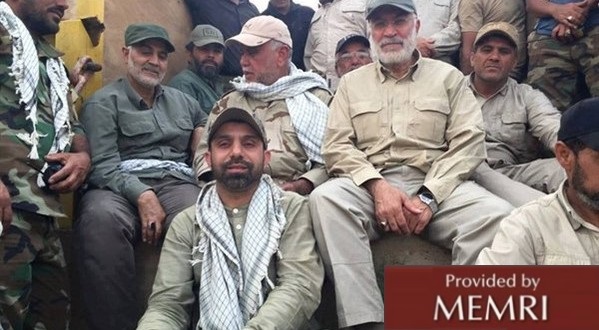Iran Targets the Gulf
إيران تستهدف دول الخليج العربي
Richard Miniter/Gatestone Institute/May 12/18
Our allies are finally becoming force multipliers — joining with America to use its talent and technology finally to defeat the jihadist threat. We should assist and encourage the UAE and Saudi Arabia, not abandon them.
More than 7,000 miles from Washington and far from America’s headlines, a war in Yemen is rewriting America’s strategy against Iran and terrorism.
The three-sided civil war pits two radical Islamist forces — Al-Qaeda’s largest surviving army and Iran’s biggest proxy force — against each other and six of America’s Arab allies. U.S. Special forces carry out covert raids and CIA drones rain down missiles on terror leaders.
The outcome of the Yemen war matters: U.S. forces are fighting there and a new strategy against terrorism is now being tested in the Middle East’s poorest nation.
Since Britain’s Royal Marines marched out of their Aden Protectorate in November 1967, Yemenis have killed each other over nearly every international ideology: colonialism, communism, and radical Islamism. Add in the tribal rivalries and the religious divides between competing versions of Sunni and Shia Islam — and the stage is set for perpetual war. Indeed, Yemen, in every decade since the 1960s, saw bombings, bloodshed and barbarism.
Iran has also seemingly been trying to form a “Shi’ite Crescent” across the Middle East, through Yemen, Iraq, Syria and Lebanon to the Mediterranean.
According to nearly half a million computer files released by the U.S. Central Intelligence Agency late last year, captured from Osama bin Laden’s compound, Iran had also offered “support to al-Qaeda in exchange for targeting the Gulf.”
The Sheikh Zayed Mosque in Abu Dhabi. Iran offered “support to al-Qaeda in exchange for targeting the Gulf,” according to CIA documents captured last year from Osama bin Laden’s compound.
In addition, Iran has been sponsoring Shia uprisings in Bahrain. The US ambassador to Bahrain during the Obama administration evidently turned a deaf ear to pleas from Bahraini officials for help; he presumably feared upsetting the president’s Iran deal, just as Obama had, by failing to act after his “red line” on the use of chemical weapons was crossed in Syria.
Meanwhile, Iran has been referring to Bahrain as “the 14th province of Iran” in its state-run broadcasts; Saudi Arabia has said Iran was behind Shia uprisings in the oil-rich “Empty Quarter,” and the UAE has placed nine Iranian entities and individuals on its terrorism list.
Following the 2011 Arab Spring, outsiders also beat the war drums. Al-Qaeda In the Arabian Peninsula — the terror network’s deadliest branch since the death of Osama bin Laden — struck police stations and army barracks while convulsing cities with improvised bombs and sniper attacks. Yemen’s elected government begged U.S. President Barack Obama for help.
Given his public statements about the Iraq War and his professed ideology about foreign intervention, Obama faced a tough decision: letting an American ally fall to al-Qaeda in the months before a presidential election or making a major military commitment that might alienate his anti-war supporters. As usual, he chose a middle course: special forces and drone strikes.
This middling effort produced middling results. Al-Qaeda forces were scattered and driven back into the arid mountains and desert wastes, but they were only beaten back, not beaten. Indeed, al-Qaeda in the Arabian Peninsula still holds roughly one-quarter of Yemen.
Meanwhile, Yemen’s government and US forces had to face an even deadlier foe: Iran-backed militias mostly populated by Houthis, an off-shoot of Shi’ite Islam.
With a common religious bond, Iranian agents built political alliances with Houthi clans with flattery, funds and strategic marriages. Their shared goal, according to Reuters, is to “‘strengthen their hand in the region,’ create a Hezbollah-like militia in Yemen, and “encircle the Saudis…, expand its influence and power projection in the region and develop levers of unconventional pressure.”
The Houthis’ effective use of small-unit tactics — similar to how U.S. infantry units learn to choreograph their movements as squads and platoons while centralizing their fire — soon routed the undisciplined government troops. The Houthis captured the capital in 2014 and have held it ever since. They dissolved the parliament in 2015, replacing it with a Supreme Revolutionary Committee later that same year.
The stakes are high. Yemen’s neighbors know that if Yemen fell to Iran’s allies, uprisings in Shia-majority pockets in Saudi Arabia and the Gulf Arab states would soon follow. America’s allies could suffer civil wars of their own, distracting them from U.S. efforts to destroy ISIS and al-Qaeda in Syria and Iraq.
The economic effects might also sap the will to fight Iran’s ambitions. Oil and gas prices would climb and Western economies would slow.
What’s more, Yemen could give terrorists a new Afghanistan, a secure base from which to map and stage attacks across Africa, America, and Asia.
So, Saudi Arabia, Egypt, Kuwait, Bahrain, and the United Arab Emirates dispatched troops, tanks, and planes. For most of those nations, it was the largest deployment of their troops, outside their borders, in their history.
America, as usual in the Obama years, provided largely “soft” assistance: snatches of phone conversations, medicine, and pallets of Meals-Ready-To-Eat.
The initial result? An appalling stalemate, in which the amount of blood-spilled per acre-regained shocked both diplomats and military planners. One Saudi military adviser told this author in 2017: “The butcher’s bill is as high as the Iran-Iraq War [was in the 1980s] and, five years later, we still have less than half of the countryside.”
Yemen’s cities reminded him of Beirut in the 1970s. “Snipers, bombs… civilians slaughtered, artillery shells landing in apartment blocks.” The career officer shook his head. He didn’t ever want to go back.
Now, the tide may be turning against the Islamist rebels.
United Arab Emirates’ aircraft smashed a key Houthi command and communications center near a strategic crossroads some 15 miles from coast.
The UAE, with Chinese missiles, has built a considerable drone force. From a room that resembles NASA’s Mission Control, more than 900-miles north of the battlefield, the UAE can now key Houthi leaders with its drones. A UAE drone killed Saleh al-Samad, president of the Houthi’s Supreme Political Council, as he exited a Toyota Land Cruiser in 2016. Many more have followed.
What does this mean for American decision-makers? Our Arab allies are working on becoming effective ground fighters, capable of expelling experienced jihadists from fortified positions, in both Yemen and Iraq. Additionally, the UAE’s new generation of drones can deliver “death from above” as efficiently as their U.S. counterparts, although it is not known for how long.
Although it might be tempting to copy this model in Afghanistan, Syria-Iraq, and across North Africa, “the problem,” as U.S. Secretary of Defense James Mattis pointed out this week, “is it’s only a matter of time before the threat manifests in a violent way.”
Once Arab government forces can help to vanquish the lands of Islamist fighters, the balance of power could shift against the terrorists.
This does not mean that the U.S. can withdraw from the Middle East, as Sen. Rand Paul sometimes suggests. It means that our allies are finally becoming force multipliers — joining with America to use its talent and technology finally to defeat the jihadist threat. We should assist and encourage the UAE and Saudi Arabia, not abandon them.
**Richard Miniter has written three New York Times bestsellers on foreign policy, including “Leading From Behind.”
© 2018 Gatestone Institute. All rights reserved. The articles printed here do not necessarily reflect the views of the Editors or of Gatestone Institute. No part of the Gatestone website or any of its contents may be reproduced, copied or modified, without the prior written consent of Gatestone Institute.






















